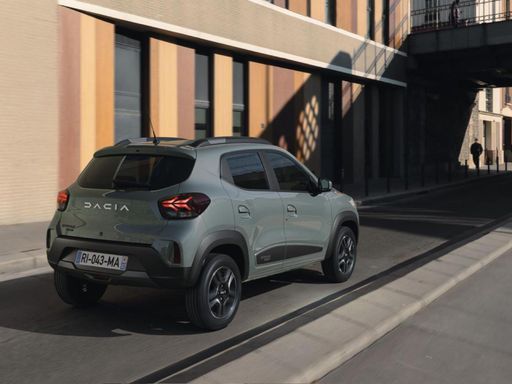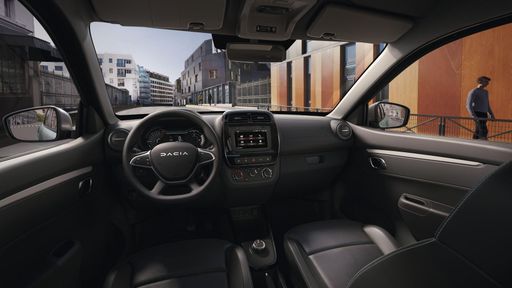Dacia Spring vs Fiat Pandina – Differences & prices compared
Compare performance, boot space, consumption and price in one view.
Find out now: which car is the better choice for you – Dacia Spring or Fiat Pandina?
The Dacia Spring (SUV) comes with a Electric engine and Automatic transmission. In comparison, the Fiat Pandina (Hatchback) features a Petrol MHEV engine with Manuel transmission.
When it comes to boot capacity, the Dacia Spring offers 308 L, while the Fiat Pandina provides 225 L – depending on how much space you need. If you’re looking for more power, decide whether the 65 HP of the Dacia Spring or the 70 HP of the Fiat Pandina suits your needs better.
In terms of consumption, the values are 13.20 kWh per 100 km for the Dacia Spring, and 5 L for the Fiat Pandina.
Price-wise, the Dacia Spring starts at 14500 £, while the Fiat Pandina is available from 14100 £. Compare all the details and find out which model fits your lifestyle best!
Dacia Spring
The Dacia Spring stands out as an affordable and environmentally friendly option in the electric vehicle market, combining practicality with a compact design ideal for urban settings. Its minimalist interior, while basic, provides all the essential features needed for a comfortable drive, reflecting its cost-effective approach. The vehicle's performance suits city driving, making it an appealing choice for those seeking an entry-level electric car.
details @ dacia-presse.de
@ dacia-presse.de
 @ dacia-presse.de
@ dacia-presse.de
 @ dacia-presse.de
@ dacia-presse.de
Fiat Pandina
The Fiat Pandina, commonly referred to as a spirited urban companion, boasts a charm that's both nostalgic and contemporary. Its compact design embraces city streets with an agile grace, making it an excellent choice for bustling environments. With a reputation for reliability and an economical approach, the Pandina continues to win hearts as a beloved everyday vehicle.
details

|
|
|
|
|
Costs and Consumption |
|
|---|---|
|
Price
14500 - 17100 £
|
Price
14100 - 18000 £
|
|
Consumption L/100km
-
|
Consumption L/100km
5 - 5.1 L
|
|
Consumption kWh/100km
13.2 - 14.1 kWh
|
Consumption kWh/100km
-
|
|
Electric Range
225 - 228 km
|
Electric Range
-
|
|
Battery Capacity
26.80 kWh
|
Battery Capacity
-
|
|
co2
0 g/km
|
co2
113 - 116 g/km
|
|
Fuel tank capacity
-
|
Fuel tank capacity
38 L
|
Dimensions and Body |
|
|---|---|
|
Body Type
SUV
|
Body Type
Hatchback
|
|
Seats
4
|
Seats
4 - 5
|
|
Doors
5
|
Doors
5
|
|
Curb weight
1013 - 1050 kg
|
Curb weight
1055 kg
|
|
Trunk capacity
308 L
|
Trunk capacity
225 L
|
|
Length
3701 mm
|
Length
3635 - 3705 mm
|
|
Width
1583 mm
|
Width
1643 - 1662 mm
|
|
Height
1519 mm
|
Height
1551 - 1657 mm
|
|
Payload
265 - 302 kg
|
Payload
365 - 385 kg
|
Engine and Performance |
|
|---|---|
|
Engine Type
Electric
|
Engine Type
Petrol MHEV
|
|
Transmission
Automatic
|
Transmission
Manuel
|
|
Transmission Detail
-
|
Transmission Detail
Manual Gearbox
|
|
Drive Type
Front-Wheel Drive
|
Drive Type
Front-Wheel Drive
|
|
Power HP
44 - 65 HP
|
Power HP
70 HP
|
|
Acceleration 0-100km/h
13.7 - 19.1 s
|
Acceleration 0-100km/h
13.9 - 14.7 s
|
|
Max Speed
125 km/h
|
Max Speed
155 - 164 km/h
|
|
Torque
113 - 125 Nm
|
Torque
92 Nm
|
|
Number of Cylinders
-
|
Number of Cylinders
3
|
|
Power kW
33 - 48 kW
|
Power kW
51 kW
|
|
Engine capacity
-
|
Engine capacity
999 cm3
|
General |
|
|---|---|
|
Model Year
2024
|
Model Year
2024 - 2025
|
|
CO2 Efficiency Class
A
|
CO2 Efficiency Class
D, C
|
|
Brand
Dacia
|
Brand
Fiat
|
Dacia Spring
The Revolution of Affordable Electric Mobility: The Dacia Spring
The automotive world has witnessed remarkable advancements in electric vehicles (EVs), with the Dacia Spring emerging as a noteworthy contender in the affordable segment. Combining efficiency, affordability, and practicality, the Spring offers an intriguing prospect for eco-conscious individuals and city dwellers alike.
Powertrain and Performance: A Look Under the Hood
The Dacia Spring is equipped with an electric motor that delivers between 44 to 65 PS, translating into a versatile driving experience tailored to urban landscapes. It operates on a front-wheel-drive system, ensuring a familiar and manageable handling experience.
Dacia Spring's electric engine is paired with an automatic transmission, utilising a reduction gearbox. This setup allows for smooth acceleration and a top speed of 125 km/h, ensuring that everyday driving scenarios are handled with ease.
Efficiency and Range: Eco-Friendly without Compromise
Efficiency is a cornerstone of the Dacia Spring's design, boasting an energy consumption of just 13.2 to 14.1 kWh per 100 km. When fully charged, its 26.8 kWh battery offers a respectable range of 225 to 228 km, making it ideal for daily commutes and short trips.
Furthermore, the Spring takes pride in its commendable CO2-efficiency class A, emphasising its commitment to reducing environmental footprint with a zero-emission profile.
Design and Practicality: Compact yet Comprehensive
Lying in the SUV category, the Dacia Spring is compact with dimensions of 3701 mm in length and 1583 mm in width, making it a perfect match for urban environments where space is at a premium. Despite its modest size, it provides a generous boot space of 308 litres, ensuring practicality isn’t sacrificed.
Comfort and Interior: For the Everyday Journey
The Dacia Spring comfortably seats up to four passengers. The cabin offers a minimalist yet functional design, available in multiple trim lines including Essential, Expression, and Extreme, allowing customers to choose according to their taste and requirement.
With its ergonomic layout and simplicity, the interior is crafted to enhance the driving experience by focusing on essential needs, avoiding unnecessary distractions.
Affordability and Accessibility: Breaking Barrier
The Dacia Spring stands out in the electric vehicle market due to its affordability, with prices ranging from 16,900 to 19,900 €. This ensures that environmentally friendly transportation is accessible to a broader audience.
Additionally, the Spring allows for cost-effective maintenance and operational expenses, offering monthly running costs between 570 to 599 € and cost per km between 22.8 to 24 cents, making it an economical choice in the long run.
Final Thoughts: The Future of Urban Mobility
In summary, the Dacia Spring serves as a testament to how electric vehicles can be both affordable and practical, without compromising on essential features. Whether it is for the eco-conscious urbanite or those looking for a cost-effective daily driver, the Spring is positioned as a viable solution for navigating the future of urban mobility.
Fiat Pandina
The Fiat Pandina: Urban Mobility Redefined
The urban jungle can be a daunting space, but the Fiat Pandina has carved out a niche for itself as a reliable and economical solution for city driving. With a solid reputation built over years of revamping and refinement, the latest versions of the Pandina continue to appeal to urban dwellers seeking a compact companion.
Modern Engineering Under the Hood
At the heart of the Fiat Pandina is its innovative Petrol Mild Hybrid Electric Vehicle (MHEV) system. This hybrid engine cleverly combines the efficiency of electric assistance with the practicality of a traditional internal combustion engine. It's a harmonious blend that provides not just superior fuel efficiency but also a reduced carbon footprint, with CO2 emissions in the range of 113 - 116 g/km.
All current Fiat Pandina models come with a 999 cm3 engine capacity and three cylinders, delivering a modest yet sufficient 70 horsepower (51 kW). This ensures that the Pandina is not just a lightweight contender in its category but also an environmentally considerate choice.
Efficient and Practical Specs
The Fiat Pandina is designed with practicality in mind, offering a consumption rate between 5 and 5.1 liters per 100 kilometers. This economical fuel consumption is perfectly suited for frequent city commutes and longer suburban journeys. Its torque of 92 Nm ensures that urban driving demands are met with ease, while the maximum speed ranges between 155 and 164 km/h, allowing a nimble performance on open roads.
Despite its compact hatchback design, the Pandina conveniently seats four to five passengers, with extra consideration given to trunk capacity, which stands at 225 liters. This blend of compactness and space ensures that you have enough room for both passengers and their belongings.
Smart Dimensions and Design
The Fiat Pandina is characterized by its smart dimensions, with a length stretching between 3635 and 3705 mm, width from 1643 to 1662 mm, and height ranging from 1551 to 1657 mm. These proportions allow for easy navigation through tight city streets and parking spots while maintaining road presence.
Weighing in at a curb weight of 1055 kg, the Pandina is a nimble companion that offers maneuverability without compromising stability. Its body type, a reliable five-door hatchback, ensures effortless access to both the front and rear of the vehicle. The fuel tank capacity is a generous 38 liters, meaning fewer stops at the pump.
A Sustainable Choice
The latest Fiat Pandina models have achieved D and C CO2 Efficiency Classes, underscoring their commitment to environmentally responsible engineering. This commitment is matched by an emphasis on driver engagement, with all models equipped with a manual gearbox that offers a direct connection between driver and vehicle.
Whether you choose the variant with slightly better fuel consumption or one with more features, every Fiat Pandina is designed to make a statement in both performance and sustainability.
Conclusion: The Urban Hero
The Fiat Pandina is more than just a car; it's a statement of efficiency, design, and modern engineering. Perfect for urban landscapes, it masters the balance between compact sophistication and the power needed for longer journeys. All in all, the Fiat Pandina continues to redefine what it means to drive in the city.
Which drive types are available for the Dacia Spring?
Available as Front-Wheel Drive.
The prices and data displayed are estimates based on German list prices and may vary by country. This information is not legally binding.
